Top Ten Reasons X-Men and Doctor Who Are Secretly the Same Franchise
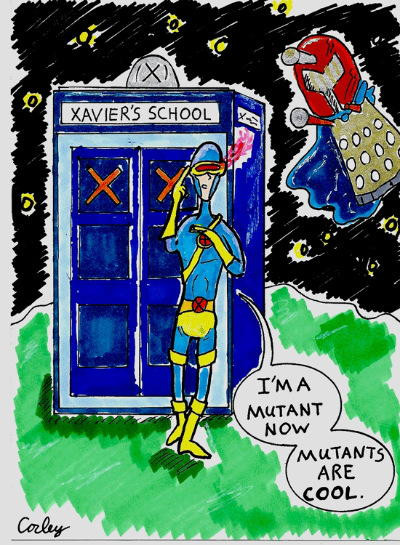 |
| Michael Corely |
2013 marks the fiftieth anniversary of two of geekdom’s most beloved franchises: X-Men and Doctor Who. (Avengers can go cry itself to sleep over this snub atop its pile of movie money and co-opted characters.) Despite their seemingly evergreen popularity, reaching this golden anniversary milestone was once thought unlikely as both properties endured protracted “wilderness years” where they were almost defunct. The disastrously schlocky TV movies both had on Fox in 1996 didn’t help their odds either.
Now that both are thriving, it’s the perfect time for these ultra-liberal sci-fi adventure tales to finally crossover. Or do X-Men and Doctor Who have so much in common that an official crossover would be redundant?
I’ve noticed a disturbingly high amount of parallels between the two properties. You may chalk them up to zeitgeisty coincidences, but my string & thumbtack collage chart (just like the ones made by every paranoid conspiracist in TV and film) says otherwise. For one thing, Chris Claremont and John Byrne, who were responsible for much of X-Men‘s classic tales, are self-professed Whovians. It’s not a one-way homage though, as Russell T. Davies and Steven Moffat, relaunched Doctor Who‘s showrunners, appear to be secret X-Fans.
I’ll be focusing on the core media for each (television and comic books) as there’s too much auxillary media to cram into a single post, but here be fifty year’s worth of spoilers. Another thing I’ve learned is that if you ever to synopsize either to the uninitiated they’ll realize you’re a crazy person. So hold on to your monocles as I explain why X-Men and Doctor Who are secretly the same franchise!
10) X-Men and the Doctor Squander Any Advantage of Being “Dead”
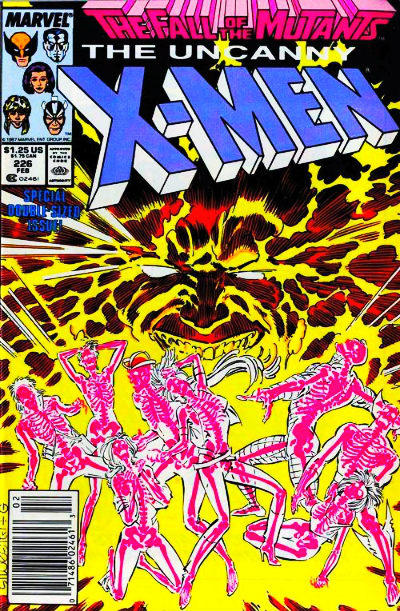 |
The X-Men sacrifice their lives to help the Goddess Roma save all creation from the generically named Adversary. Roma resurrects them with the bonus of being undetectable by electronic means, such as video cameras, as if they were vampires. The X-Men, who were publically regarded as outlaws because their Avengers and Fantastic Four “friends” never put in a good word for them with the authorities, think this new ability to work under the radar is great.
The downside is that media outlets can no longer get proof of the X-Men protecting the world as pro-mutant PR. They really needed it as X-Factor (the original X-Men) had been masquerading as mutant hunters to find new mutants to train. (That’d be as counterproductive as the NAACP dressing as KKK to promote tolerance.) They certainly weren’t as productive as their mentor, Professor X, who’d once let a shapeshifter die in his place so he could have plenty of time to brainstorm how to vanquish an alien invasion without whiny teens bothering him. The team’s tactical advantage of being undetectable doesn’t last long as racist cyborg Reavers have scanners that are unaffected by magic. The rumors of their deaths being slightly exaggerated is blown to the world when the team is tried by kangaroo court in apartheid Genosha. This stealth enhancement barely lasted until the next writers literally forgot it was a plot point.
The Doctor’s braggadocio earns him the enmity of the Silence, a religious order devoted to his downfall composed of useless soldiers, dime store Nazgul, and amnesia-inducing aliens from a Munch painting. He gets them off his back by ensuring that River Song “kills” a robotic decoy of him, for which his wife is dutifully imprisoned on a bum murder rap to maintain the trick.
How such a cacklebladder can be sustained when the Silence can also time travel is never addressed. The Doctor certainly doesn’t make it easy on himself since he continued to associate with the Ponds and still hasn’t fixed his TARDIS’s Chameleon Circuit. It’d be the perfect opportunity for him to dye himself ginger. Clara Oswin does erase his files from most databanks, but the Cybermen explain they could easily reconstitute this data from the digital abscesses she left behind. If the Doctor does manage to stay off the grid as a dead man, it won’t be because he’s playing it clever. It’ll be because the writers forgot the Silence existed when they stopped looking at them.
9) Suppossedly Impossible Paradoxes Overwrite the Whole Universe
According to Who, some events in time are fixed whereas others are mutable, but you’d have to be Gallifreyan to tell the difference. Whether or not Egyptian God Sutekh destroys Earth in 1910 is shown as being completely variable, although the entirety of the show hinges on that not happening. Of course “time can be rewritten” even when it comes to fixed events, which makes this distinction meaningless.
When River opts not to shoot the Doctor-shaped Teselecta (which we are told is a fixed point in time), reality instantly morphs into one giant anachronism in danger of imploding. So instead of being completely immutable, that event turned out to be the easiest thing to screw up in a bajillion ways. Rather than being somewhat elastic, the space-time continuum is akin to a game of Jenga. (The universe does get reset once the Doctor reveals to River that she won’t really kill him when she shoots “him,” so she does.) The Doctor crossing into his own personal timeline (which we’re told is the one thing he absolutely must never do) after the Great Intelligence and Clara were fragmented throughout it ought to be even worse, but who knows if there will be any lasting consequences? This program kinda has a spotty record when it comes to follow through.
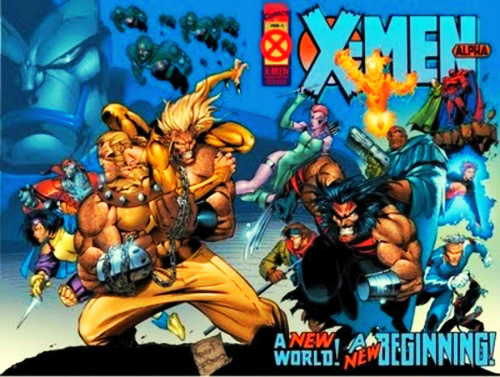 |
The official Marvel rules of time travel avoid paradoxes by insisting that it’s only possible to visit alternate reality timelines. X-Men pisses on this rule whenever possible. Professor X’s bastard son, Legion (who inherited the toothbrush hair genes from his mom), goes back in time to kill Magneto before he becomes a supervillain. Instead, he accidentally kills Xavier before he formed the X-Men or had unprotected sex. (There’s an icky scene that suggests Legion becomes his own dad for a bonus bootstrap paradox or to negate the inherent grandfather paradox.) This causes the entire Marvel universe to shift to a world conquered by Apocalypse, a self-professed former Sutekh impersonator.
The timeline is corrected when Bishop is sent back again (just to score this arc a Blinovitch spot on the paradox bingo) to kill Legion before he slays anyone. Of course Legion is now alive and headlining X-Men Legacy for reasons that don’t explain anything. Despite being erradicated, the “Age of Apocalypse” has now become a distinct alternate reality so it can be Marvel’s most nihilistic cash cow.
8) Invertebrate TV Overlords Deliver Meta-Commentary
When it comes to meta-commentary, X-Men has Mojo, an obese histrionic invertebrate in a robotic scorpion chair. He rules the Mojoverse dimension where television ratings are power and the violent struggles of mutants are catnip to his couch potato subjects. Keep in mind that he was invented years before humanity realized that reality shows were the opiate of the masses and bane of civilization. He even had his top henchwomen, Spiral, insert cameras into Psylocke’s eyes so they’d get a constant video feed of superheroics. (She later turned the Caucasian Psylocke into a Japanese ninja in an over the top parody of the “Two Darrins” effect.)
When the X-Men are unavailable, Mojo creates the X-Babies as a quick cash-in, much like Disney will eventually. You’d think Mojo would be a one-off joke, but he’s actually become a recurring villain who appeared in two cartoon adaptations to add an extra layer of meta. His continued exploitation of mutants (and his genetically engineered humanoid slaves that the X-Men can’t be bothered liberating) mocks Marvel for pandering to fans who buy X-books just for superpowered fisticuffs rather than the thought-provoking human rights issues at its core. His presence underscores the fact that the X-Men are really just an entertainment commodity.
See also the ironically abbreviated “AvX,” the sprawling cross-over slugfest that throws both the X-Men and Avengers under the bus because of a magic RPG between junior members Pixie and Squirrel Girl.
The Doctor practically knocks down the Fourth Wall in “The Greatest Show in the Galaxy,” which satirized its creators, fans, and BBC brass. It’s so meta that it’s basically The Cabin in the Woods two decades ahead of schedule.
Not content with having the more subtle critique, the revived Doctor Who blatantly rips off the Mojoverse. In “The Long Game,” all media for the Fourth Great and Bountiful Human Empire is controlled by Mighty Jagrafess of the Holy Hadrojassic Maxarodenfoe, a giant carnivorous slug stuck to the ceiling of Satellite Five’s control room. Just as Mojo has a wry major domo in the android Major Domo, the unintelligible Jagrafess had a wry factotum played by an albino Simon Pegg.
That’s one point for Who, though it still loses to X-Men for not including a teleporting six-armed swordswoman like Spiral. (Also, the predatory yet flatulent Slitheen who disguise themselves by wearing humans’ skins were totally inspired by Mojo’s predatory yet shiny Warwolves that disguise themselves by wearing humans’ skins.) Even in the distant future, this popular TV show insists that television will still be the preeminent medium for propaganda, especially if it’s broadcast by a BBC stand-in.
At the end of series one (or twenty-seven, depending on how you’re counting), Satellite Five’s deadly reality shows are taken over by Daleks because there’s no greater shorthand for creative bankruptcy. Lazy Who writers slap Daleks on everything!
7) Beneath Their Saintly Reputations, the Doctor and Professor X Are Secretly Jerkwads
The general view of the Doctor as an itinerant savior has recently been called into question by Davros, the Silence, and the Great Intelligence. While they lack moral authority, their cynicism is supported by the series.
When the Doctor debuted he was a curmudgeon who wanted to bludgeon a caveman to death for expediency. He mellowed as he spent more time with humans but still has bouts of sociopathy. He has the chance to preemptively wipe out the Daleks but decides it’s not right to prevent them from waging genocidal campaigns against the rest of the cosmos. After telling Sarah Jane she wasn’t allowed to come to Gallifrey with him, he drops her off in Aberdeen instead of South Croydon. Because of his shoddy repairs, the Xoanon supercomputer became a schizophrenic with the Doctor’s visage and split the explorers it was designed to help into warring cargo cults. The Doctor belligerently installs himself as President of Gallifrey (with Leela in tow) just so he could discover the Vardan invasion he let in was a front for the Sontarrans.
The Sixth Doctor’s first order of business was to choke new companion Peri and declare her his servant. He exposes Ace to all her fears to break her down. Then’s there’s the whole “killing all the Daleks and Gallifreyans during the Time War” thing. When chased by the Family of Blood, he surrenders all his advantages by becoming a powerless human school teacher while Dr Martha Jones has to settle for being as maid in 1913. It wasn’t until the Family kills a bunch of townsfolk that the Doctor decides that subjecting the monsters to arabesque tortures (which appears ridiculously easy once he reverts back into a Time Lord) was a better strategy.
He keeps Clara in the dark about her timestream doppelgangers for flimsy reasons even after it’s proven she’s not a Trojan Horse. He can also stand to treat his wives, the TARDIS and River Song, much better.
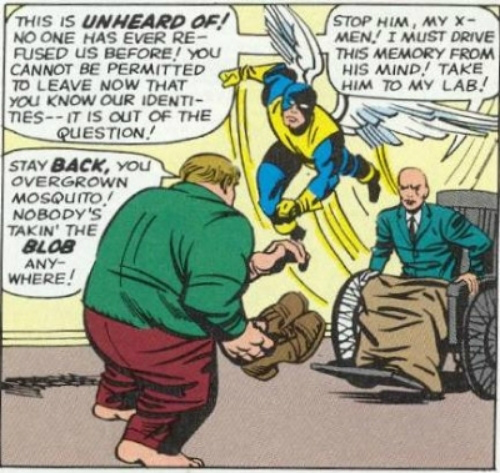 |
The general view of Professor Xavier as the visionary who realized mutants and humans should live together in harmony was recently called into question by the X-Men after a cemetery’s worth of skeletons fell out of his closet. These incriminating retcons are supported by the early comics, which revealed that Professor Xavier had a cavalier habit of erasing the minds of supervillains, superhero allies, and his students’ parents. He also never told the public that his school trained mutants to control dangerous powers (until he was possessed by his long-lost evil twin sister) or that the X-Men support peaceful coexistence, which would’ve gone a long way to reducing anti-mutant hysteria.
Xavier strangles his twin sister in utero and abandons his step-brother in a temple cave-in, which caused his siblings to resurface years later as angry supervillains. In order to rescue the original X-Men from Krakoa the Mutant Island, he sends a trainee X-team that promptly dies. He erases everyone’s memories of the dead X-Men and uses telepathic ventriloquism to make Krakoa speak English (he thinks that it helps his cover-up somehow) rather than helping the untrained international X-Men he sent in afterwards. To his ex- fianc?e, world class geneticist Dr. Moira MacTaggert, he grants the lofty position of school housekeeper. When he found out an alien upgrade made the Danger Room sentient, he still forces it to torture his students in mock combat. He has the hubris to try to rehabilitate Sabretooth in the mansion against everyone’s better judgement, which gets Psylocke gutted. Xavier even had to spend an extended arc apologizing to everyone Twelve Steps style.
If he doesn’t sound quite as bad as the Doctor, it’s only because Xavier has to jockey with so many other muties for page time.
6) … and Their Repressed Bastardry Coalesces into Sentient Supervillains
The usually benign Fifth Doctor literally lets the Master die in a fire as he screams for mercy. (He gets better.)
The exceptionally dickish Sixth Doctor is put on trial by the Time Lord High Council for committing genocide on the obscene-looking Vervoids amongst other crimes (but not against fashion). The prosecutor, the Valeyard, turns out to be a possible penultimate incarnation of the Doctor distilled from his inner bastardry into an outright supervillain. The Valeyard rigs the trial’s evidence in an attempt steal the Doctor’s remaining regenerations upon his execution before betraying the High Council. “The Trial of a Time Lord season was so reviled that the show was put on hiatus for eighteen months, and the Valeyard was put off limits because his origin makes no sense. Although the show finally returned, it was living on borrowed time until the BBC officially axed it.
In the relaunch, The Doctor faces The Dream Lord, another foe sprung from his subconscious. John Hurt’s Doctor must be even worse than either of them to merit a time out!
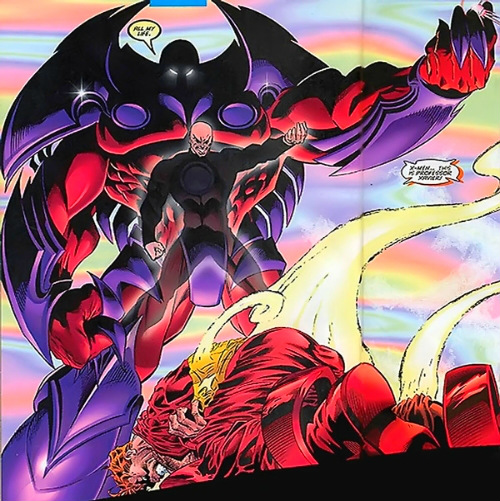 |
At one point during which he constantly nags others about the ethical usage of mutant powers, Professor X completely erases Magneto’s brain. (He gets better.) The X-Men are defeated from within by the long foreshadowed and ?ber-powerful Onslaught. Despite looking like the shamebaby of Magneto and Super Shredder, the new villain is revealed to be another astral manifestation of Xavier’s bastardry. (In an earlier crossover, Xavier’s evil subconscious called the Entity conquers the Microverse whilst dressed as a gladiator and literally brainrapes student Dani Moonstar.) Onslaught’s threat to the whole Marvel universe is vanquished at the cost of everyone who wasn’t an X-Man or Spider-Man being exiled to the “Heroes Reborn” reboot universe. Do I really need to embed pictures of Rob Liefeld’s Captain America for you to see that this was a dark time indeed? At least Xavier is finally sent to the clink afterwards for this heinous crime.
5) Magneto and the Master Use the Same Scheme
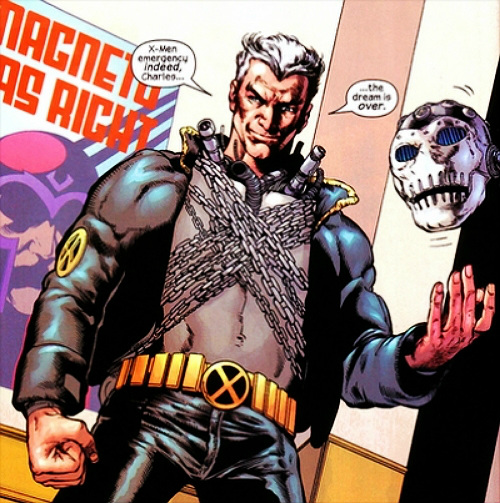 |
The fact that Magneto is Professor X’s friend turned insane arch-nemesis has launched innumerable slashfics. After Sentinels obliterate Genosha, Magneto is presumed dead. Marvel even enacts an official “dead means dead” policy to convince readers it’s for realsies this time. In actuality, Magneto disguises himself as Xorn, an imprisoned Chinese Buddhist with a star for a head under a metal skull mask. (Nobody told him yellowface isn’t cool.) Rather than do a thorough background check, Cyclops invites him to teach the Xavier School’s “special class” of lame muties. After he leads the X-Men into various death traps, Magneto and his new Brotherhood (the former “special class”) turn NYC into an anti-human concentration camp because he lost his sense of irony when he got addicted to Kick off-panel. He keeps Xavier in a stasis tube so he can witness his triumph as Magneto wistfully monologues to him. While distracted by Beak, the reunited X-men kick his ass. Realizing he was more important to the world as a mythic symbol than a live junkie, he lets Wolverine behead him.
This story was problematic as it regresses Magneto from a multi-faceted anti-hero to a one-note psycho. So the next creative team has Magneto quickly resurface in Genosha’s ruins with no memory of his recent atrocities. Either Xorneto was really a new mutant named Xorn pretending to be Magneto pretending to be Xorn, or Scarlet Witch resurrected her decapitated dad with amnesia using her hex powers. Don’t think too hard about either solution and just move along like Marvel did.
The fact that the Master is the Doctor’s friend turned insane arch-nemesis has launched innumerable slashfics. Following the events of the TV movie, the Master is presumed dead. In actuality, the Time Lord High Council resurrects him as a conscript in the unseen Time War. The Master wisely runs away to the far future, disguising himself as kindly human Professor Yana. After Martha Jones accidentally blows his Chameleon Arch cover, the Master steals the Doctor’s TARDIS and leaves the Doctor to be eaten by refugees from an 80’s post-apocalypse film. In the present, the Master is elected the UK’s Prime Minister under the name Harry Saxon because widespread cell phone hypnosis trumps thorough background checks.
Then he conquers the Earth by bringing the Toclafane (human Dalek impersonators) back in time to kill boatloads of people. The Master turns the Doctor into Dobby and keeps him in a birdcage so he can witness his triumph and Scissor Sisters musical numbers. After a year of total domination, Martha distracts him so that world can wish the Doctor back into David Tennant, Tinker Bell-style. Jack Harkness shoots the Paradox Generator (as if this show needs one) to retcon the Master’s victory from the history books. Rather than being imprisoned aboard the TARDIS, the Master lets his wife fatally shoot him. This wasn’t a hurdle to future appearances since the Master can regenerate into a new actor. Instead of using this simple solution, however, a secret cabal of Saxon loyalists resurrects him using what amounted to magic potions. The risen Master keeps his most recent visage and Jokeresque personality but gains perpetual munchies, lightning blasts, an intermittent skull face, and a bad dye job. The BBC could only afford so many non sequiturs.
4) The Non-Linear Origins of Cable and River Song Are Identical
When the Doctor first encounters Professor River Song in the Library, she already knows him and what his future holds. Later on, Madam Kovarian of the Silence kidnaps the baby of tempestuous ginger Amy Pond and Rory Williams to mold into the Doctor’s assassin. Because of a translation error, Melody Pond becomes known as River Song.
River possesses some Gallifreyan attributes such as regeneration as a result of being conceived aboard the TARDIS. Although she is usually older than them, River hung out with her parents when they were teens in an earlier form called Mels. River breaks the Silence’s brainwashing by falling in love with the Doctor. She allows the galaxy to think she’s the worst murderess of all time so the Doctor can operate under the radar. Upon parole, she becomes a professor of archaeology. River Song is very fond of shooting things. She and the Doctor got married during the collapse of a pocket universe so I don’t know if anyone besides them recognizes this union. Her parents take this surprisingly well. River Song could only be more confusing if she had an evil twin that dressed in armor made of chrome spikes and giant X-Acto blades.
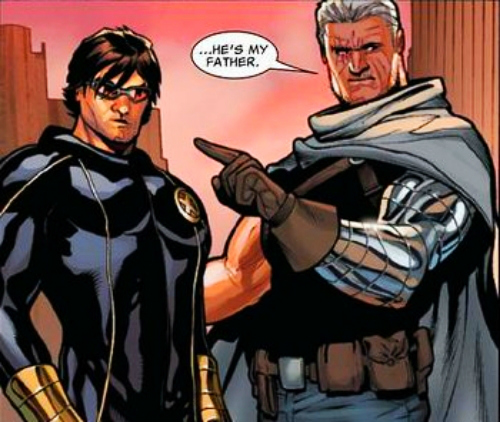 |
If that non-linear origin sounds familiar, it’s because Cable was already using it. When the uncreatively named New Mutants first encounter Cable in Genosha, he already knows them and what their future holds. That’s because Cyclops and tempestuous ginger Madelyne Pryor had a son named Nathan Summers. Apocalypse infects baby Nathan with a techno-organic virus, and the Askani sisterhood takes Nathan to the future in hopes of curing him. The virus afflicts Nathan with a big shiny arm and a light-up eye on top of his psionic powers. The Askani (led by his sister from another future, Rachel Summers) train him to be Apocalypse’s assassin. Cyclops and Jean Grey later travel to the future under uninspired false names to help raise him too.
He travels back to the present where he’s older than his father and takes the name Cable for reasons that are dull. He doesn’t mind being labeled a terrorist while he wages his secret war against Stryfe, his evil pointy-armored clone, and Apocalypse. During his freedom fighting, he somehow finds time to earn a seldom used law degree. Cable is very fond of shooting guns the size of mastiffs. The biggest difference between him and River is that Cable hasn’t declared his undying love for Apocalypse and eloped with him in a pocket universe … yet.
3) Jean Grey and Rose Tyler Become Cosmic Avatars
Jean Grey is kind of a big deal because she was the first female X-Man. Unfortunately the former Marvel Girl was also pretty vanilla. To spice her up, Jean bonds with the nigh-omnipotent Phoenix Force whilst trying to pilot a damaged space shuttle filled with X-Men through deadly cosmic rays (they only grant you powers if you fly an intentionally unshielded craft through them). Despite saving the all reality by protecting the M’Kraan Crystal with her massive everything upgrade, the Jean-Phoenix gestalt can’t reconcile human emotions with cosmic awareness.
She’s further unhinged when the Hellfire Club makes her reenact an episode of The Avengers (not the kind Marvel has the rights to). She becomes Intergalactic Enemy #1 after noshing on a star that kills five billion broccoli aliens. Rather than risk losing control again, Phoenix allows herself to be killed by an alien super-weapon. Her grieving boyfriend, Cyclops, then marries Madelyn Pryor, a human clone of Jean. Once Jean resurfaces alive and well (Phoenix, duh) via a confusing retcon, Cyclops leaves his wife and child to be with her because that’s what heroes do!
Rose Tyler is kind of a big deal to Whovians introduced by the relaunch as she’s their introductory companion and the first one the Doctor fell in love with. (They’d missed him snogging Dr. Grace Holloway in the TV movie.) Despite being a Chav, however, Rose is pretty vanilla. To save the Doctor and Captain Jack Harkness from the Daleks, Rose looks into the TARDIS’s time vortex.
Now infused with temporal energy, the Rose-TARDIS gestalt calls itself the Bad Wolf. She resurrects Jack with bonus immortality and erases Daleks from the timestream. (This is about as permanent as when Phoenix erases the Sublime bacteria from the timestream.) Rose’s human body can’t handle her power upgrade, so the Doctor sacrifices himself by sucking the energy out of her. Then he rises from the dead because Time Lords regenerate. Despite being trapped in a parallel universe, Rose resurfaces in the main universe during the latest fourth season. Rose currently resides in that altverse with a human Doctor clone as a consolation prize because that’s what sidekicks do!
2) Time Travellers Can’t Exactly Prevent Fascist Futures
According to “Day of the Daleks,” the Earth will be conquered by Daleks (I bet you thought I was going to say Movellans) in the twenty-second century. Since Daleks are thinly veiled Nazi analogues, this isn’t something to look forward to. Human freedom fighters travel back in time to kill some diplomats at a peace summit in hopes of averting this future. The Doctor discovers the rebels got their intel backwards, and stops the Daleks from ruling the world by thwarting the assassination. There may be a grandfather paradox in there.
“The Dalek Invasion of Earth,” however, shows that this nightmarish twenty-second century couldn’t have been completely altered because that’s where the First Doctor abandons his granddaughter. It’s also the plot of the non-canonical Daleks?Invasion Earth: 2150 A.D. (and you thought X-Men Origins: Wolverine was the clunkiest title around) movie with Peter Cushing. It’ll probably be recycled again in the next instance of writers’ block at the BBC. It’s almost as if it’s secretly the most fixed timeline of all.
According to “Days of Future Past,” the Earth will be conquered by Sentinels in 2013. Since Sentinels are thinly veiled Nazi analogues, this year will really suck (and not just because the movie adaptation is a year late). Our nightmarish present is ironically caused by the Brotherhood of Evil Mutants assassinating Senator Kelly to protect mutant rights. To avert this, Rachel Summers sends Shadowcat’s mind (replaced in the cartoon with Forge and Bishop for more racial diversity and less feminism) back in time into her teen body to tip off the X-Men.
With the assassination thwarted, 2013 is safe for mutants and humans alike. Or at least it would’ve been if Marvel didn’t keep going back to the same dystopian well even though “DoFP” was intended as a standalone story. Because Marvel time travel is only supposed to be possible to alternate timelines, Rachel Summers borrows her mom’s old codenames and takes refuge in in the main timeline since her world didn’t get fixed. Fellow time traveler Bishop hails from another “DoFP” variant. Marvel even foreshadows the main universe will eventually become like “DoFP” whenever stakes need raising.
So 92% of all possible futures are genocidal nightmares run by Sentinels. The remaining 8% are genocidal nightmares run by Apocalypse.
1) Both Have Incomprehensible Continuity Because Neither Understands How Time Travel Works
You’d think that a TV show based time travel would have an understandable system of how it works. On Doctor Who, the mechanics of time travel are “a big ball of wibbley-wobbly timey-wimey.” Seriously. Even when there are rules for handling paradoxes they’re rarely consistent beyond a single story (if that), which wouldn’t be so problematic if the program was a true anthology.
The Blinovitch limitation effect, for instance, means that meeting yourself from another point in time is equivalent to crossing the streams in Ghostbusters. When two ex-Brigadier Lethbridge-Stuarts touch, it gives them brain damage and unleashes a catastrophic surge of temporal energy. The Doctor, on the other hand, safely interacts with himself all the time whenever there’s a multi-Doctor story. Even though each incarnation is played by a different actor, this danger should still exist since they’re all the same being.
Maybe there’s a special Gallifreyan loophole, but the same can’t be said for Rose Tyler meeting herself as a baby in “Father’s Day.” Furthermore, Rose creates a paradox so awful it breaks the TARDIS by saving her dad’s life. Then paradox-eating Reapers appear to eat all the extras until Rose’s dad unparadoxes things by committing suicide via a perpetually lost car. This makes the Reapers disappear from the series forever because they suck so much. This episode is is well regarded by fans that place more importance on emotional manipulation than internal consistency.
Since the 2005 relaunch was more of a continuation than a true reboot, it’s merely one more exception to add to the quagmire. The audience doesn’t need to know all the time travel rules, but it’d be nice if the writers did.
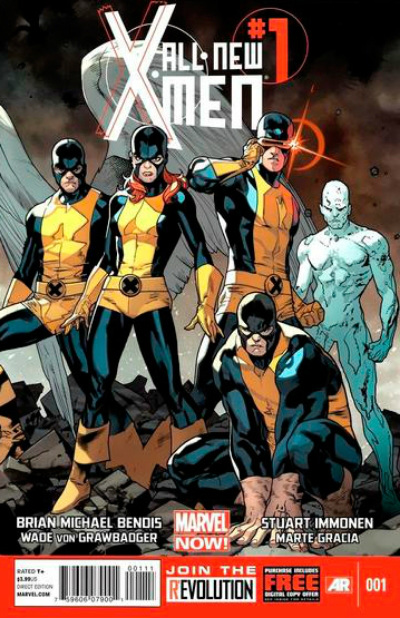 |
As shown by “DoFP’ and “Age of Apocalypse,” X-Men doesn’t have the luxury of sweeping its nonsensical time travel retcons under the rug and moving onto a new unconnected story. Recently, the original X-Men have been whisked from the past to the present to star in the ironically titled All New X-Men. Because who wants to give neglected characters any limelight when you can spotlight redundant versions of characters so white bread that they got the original title stuck in reprint Hell for five years?
After feuding with Cyclops over abusing power, Beast hypocritically brings the team to the first present so that his younger self with no doctorate can save his life instead of enlisting the aid of a presumably smarter future self like any sane person with a time machine. With Beast’s life saved, the original X-Men stick around in the present for no reason. Honestly, there is no narrative reason that prevents Beast from sending the younger X-Men back where they came from to preserve history. It’s brought up offhandedly that their continued presence will wreck the space-time continuum yet they still don’t think that’s incentive to go home. The longer they stay here accumulating spoilers, they less likely any X-Men continuity will be upheld when they return.
Teen Jean’s powers in the present have already far surpassed the level they were at when she was plucked from the past. Because the “sliding timescale” (the confusing meta-textual tool used to compresses fifty years worth of stories into thirteen to keep the most marketable characters from becoming decrepit) means they’re more like 2000’s X-Men than 1963’s, however, there isn’t even enough culture shock hijinks to compensate. If they get mindwiped or turn out to be from an alternate past, the paradox problems get solved, but it makes this story an even bigger crime against trees. The entire state of affairs is so problematic that X-Men from the future will come back to the present to kick their old school asses in this year’s “Battle of the Atom” crossover.
That’ll teach those whippersnappers that the present is only for refugees from Sentinel-ruled futures!

